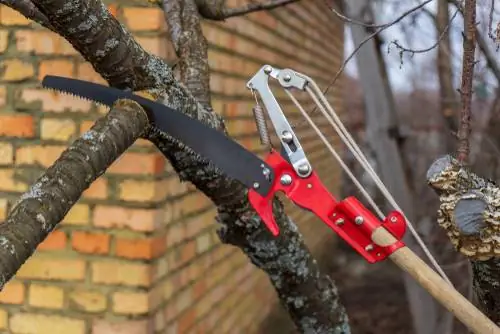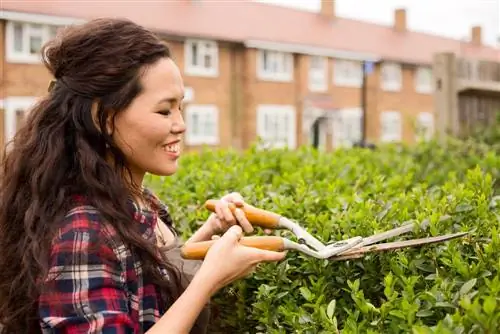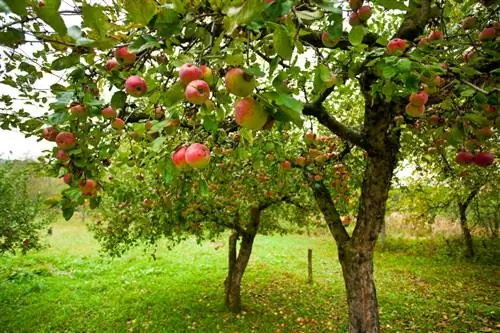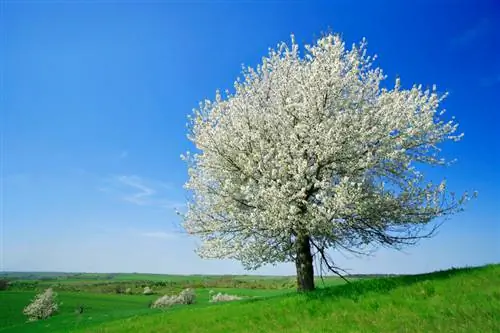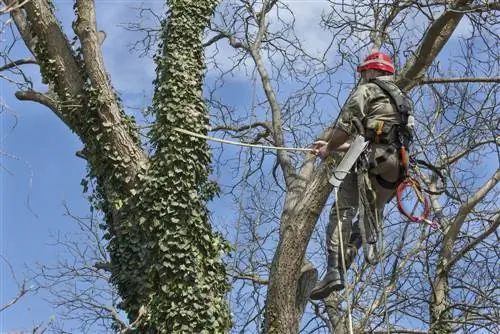- Author admin [email protected].
- Public 2023-12-16 16:46.
- Last modified 2025-01-23 11:19.
The sweet cherry occupies a special position in the pruning care of fruit trees. The pronounced sensitivity to cutting only allows maintenance cutting every few years. Without occasional pruning, fertility leaves much to be desired and the tree ages. This guide explains how to properly prune an old cherry tree and optimize the harvest yield.

How do I prune an old cherry tree correctly?
To properly prune an old cherry tree, carry out a phased rejuvenation pruning over three years in late winter. Always cut old crown branches to cones rather than to astring to reduce stress and promote new fruiting wood.
Pruning time in late winter
An old cherry tree is busy in summer. Birds have chosen the dense crown as their nesting place. Crowds of useful insects cavort in the aged branches. As a result, recommendations for summer rejuvenation pruning fall on deaf ears among responsible home gardeners. This is also how the Federal Nature Conservation Act sees it. Paragraph 39 stipulates that radical cutting measures must be carried out between October 1st and February 28th to protect our massively threatened wildlife.
Cut old cherry in stages
So that an old cherry tree can cope with the rejuvenation cut, you should proceed in stages. Spread the measure over three years. From the second year onwards, a summer care cut complements what started the winter cutting phase. You can successfully revitalize an aging cherry tree with the following strategy:
- The best time is in February when the weather is frost-free and dry
- Thin out one third of the crown at a time
- Cut back dead and awkwardly positioned branches to 10-20 cm long cones
- Heavily overhanging leading branches lead to a young side shoot near the trunk
Every thinning cut causes the cherry tree to sprout vigorously. In the second and third year, you subject already rejuvenated crown sectors to a regular maintenance cut. Once you have rejuvenated the entire crown, pruning care results in pruning at intervals of three to four years after the harvest time.
Tenon cutting alleviates rejuvenation stress
Please always cut worn-out cherry crown branches to cones instead of to astring. With this cut you reduce the stress on the old fruit tree. There is also a good chance that fresh shoots will sprout from the 10-20 cm long stubs, which are suitable for fruiting wood. After two years, select the two most promising shoots for each cone. All remaining branches and cones are removed after the summer harvest season.
Cut off thick branch piece by piece
When rejuvenating the old cherry tree, you will be confronted with numerous thick branches that need to be removed. From a diameter of 10 centimeters, cut the branches piece by piece into cones. First, saw the branch from below at a distance of 30 centimeters from the trunk. Move the saw slightly so that you can now saw from above. The branch then falls to the ground. Finally, cut the stump into tenons.
Tip
Sour cherries play in a different league than sweet cherries when it comes to pruning care. Juicy morello cherries thrive on last year's shoots. Delicious sour cherries are produced by the one to three year old fruit wood. This behavior requires annual maintenance pruning following the summer harvest.

